|
It was early spring in peak season
2005 and Masada was crowded. I was waiting for
my group to assemble in the lobby of the visitors’
center when I heard a cacophony of voices shouting
in Hebrew near the ticket office. I edged
closer and saw that the argument was about whether
the group’s guide had to pay the considerable fee
for the cable car ride up to the summit. The
guide, who was actually an archeologist, had
forgotten to bring his guide license. |
|
|
|
As I leaned forward, I recognized the guide, the
eminent archeologist Meir Ben Dov, who had been the
major assistant to Benjamin Mazar at the excavations
surrounding the Temple Mount after the six day war.
I shouted out to the cashier at the ticket counter,
“Don’t you recognize this guy? This is
the esteemed archeologist, Meir Ben Dov, who
excavated the southern steps leading up to the
Temple Mount. He deserves to ride the cable
car for free!” “Oh we didn’t know,” replied
the ticket vendors. |
|
|
|
Then as he turned around to see who had gotten him a
free pass, I inched closer so we were almost head to
head. I lifted my sunglasses and said, “Take a
good look. The next time you see me, you have to let
me in for free!” |
|
|
|
By that time, my group had assembled and we climbed
the stairs to queue for the cable car. As luck
would have it, as my group squished into the cable
car filled to its capacity of 65 passengers, I saw
that we were sharing the cable car with that Israeli
group. |
|
|
|
And that Meir Ben Dov had seen me. (I am tall
and very recognizable, usually wearing a colorful
baseball cap matching my outfit.) He was
worming his way through the people in my direction.
I guessed he wanted a word with the cheeky guide who
had spoken up on his behalf. |
|
|
|
I thought quickly to myself, hey Gila, you have an
opportunity to ask Ben Dov one question – what
should it be. In 2005, what was bothering me
was the raging controversy over whether the first
temple period “ivory pomegranate” once displayed by
an antiquities dealer on the Via Dolorosa in the Old
City and identified by a French scholar named Andre
Lemaire and then bought by the Israel Museum was
genuine or a forgery. |
|
|
|
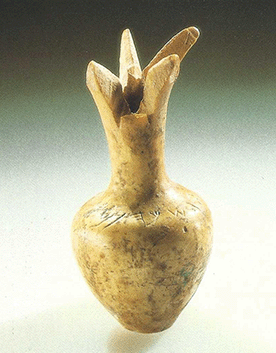 |
|
|
|
The background is this: In 1979 André Lemaire saw
the "ivory pomegranate" for the first time in the shop
of an antiquities dealer in Jerusalem and asked
permission to photograph it. Two years later he
published an article in a French journal outlining his
view why the artifact was authentic. In 1984 he
published an article in the popular magazine Biblical
Archeology Review (which I read). It created quite a
stir. |
|
|
|
In the meantime the artifact was sold, smuggled out
of the country and disappeared. |
|
|
|
In 1987 the Israel
Museum was approached to buy the pomegranate. A year
later, after it had been authenticated by the
respected well-known archeologist Nahman Avigad, the
Israel Museum paid $550,000. The money from an
anonymous donor was deposited in a numbered Swiss
bank account, after which the buyer was directed to
a safe containing the pomegranate. Two years later
Professor Avigad published an article in The
Biblical Archaeologist outlining the evidence for
the authenticity of the Ivory Pomegranate which he
believed to be an object used in priestly rites in
the First Temple. |
|
|
|
The object of the controversy was a thumb-sized
ivory object, probably the head of a scepter carried
by the temple priests. If it was indeed genuine,
then it more than likely would have been present at
one time or another in Solomon’s Temple which stood
in Jerusalem until it was destroyed by the
Babylonians in 586 BC. |
|
|
|
The ivory colored object is shaped like a
pomegranate, with a central ball (called a grenade)
and a thin neck that extends upward into what was
once six petals. Four of the petals remain. One side
of the grenade is broken off. At the bottom there is
a hole where a scepter rod had presumably been
inserted. |
|
|
|
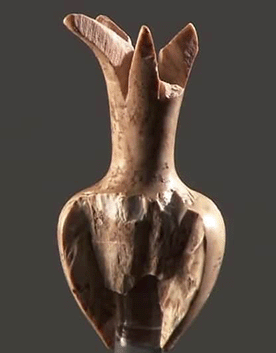 |
|
|
|
The most important part of the ivory artifact is a
nine-letter inscription in ancient Hebrew writing of
which only six letters are legible. The inscription
around the shoulder was dated to the 8th century BC
and said, “Belonging to the Tem[ple of Yahwe]h, holy
to the priests. In transliterated Hebrew lby[t yhw]h
qdsű khnm. Only a portion of the inscription has
been preserved, since a third of the shoulder was
broken off. (Note the letters added by researchers are within
brackets.) |
|
|
|
Several of the letters of the inscription are
fragmentary, having been impacted by the break. The
question is whether the letters were inscribed
before the break occurred (meaning they are genuine)
or afterwards (meaning the inscription is a fraud).
Another possibility is that the break may have
occurred during the attempt at forgery. |
|
|
|
After the purchase, the pomegranate immediately went
on display in the Israel Museum. |
|
|
|
I loved showing my groups the ivory pomegranate and
explaining about the inscription. To this day,
twenty years later, I remember precisely where it
was exhibited, right after the exhibit of stone
sling balls and parts of an ancient sling (I love
talking about slingshots), at the top of four steps,
at the entrance to the hall with artifacts from the
second temple period. |
|
|
|
The ivory pomegranate was the shining star of my
unique “Gila’s top ten not-to-be-missed exhibits
relevant to bible students in the archeology wing of
the Israel Museum.” Everyone who still had stamina
after seeing the model of second temple Jerusalem
and the Dead Sea Scrolls participated. My groups
were fascinated by the thought that this small
inscribed object may have been carried in Solomon’s
Temple. |
|
|
|
In Exodus 28:33-34 there is a description of the
robe of the high priest with the added instruction,
“On its hem make pomegranates of blue, purple and
crimson, on its hem all around, with bells of gold
wihtin them all around. A golden bell and a
pomegranate, a golden bell and a pomegranate, on the
hem of the robe all around.” |
|
|
|
During the time of the Second Temple, the bells and
pomegranates had a special function. On the Day of
Atonement, Yom Kippur, the high priest entered the
Holy of Holies with a rope around his ankle so that
if he had a heart attack or happened to faint, the
bells and pomegranates would sound an alarm, so to
speak. No one else could enter the Holy of Holies,
but the high priest could be yanked out by rope
without anyone desecrating the divine space. |
|
|
|
The pomegranate itself is a delectable fruit. And
today we even know that it is super nutritious.
In Jewish tradition it represents fertility because
of its many seeds. The first commandment in
the bible is: “Be fruitful and multiply.” The
pomegranate was one of the seven species brought by
pilgrims to the temple during the holiday of Sukkot
or Tabernacles. |
|
|
|
 |
|
Photo: Gila
Yudkin |
|
Pomegranates in Jewish tradition
are a symbol of fertility |
|
|
|
As the controversy raged with arguments back and
forth, to my chagrin, the Israel Museum removed the
ivory pomegranate for “further study.” Then in
late 2004
the Israel Museum announced that, after further
investigation by a team of scholars, the Ivory
Pomegranate was a fake. |
|
|
|
So not too long afterwards I found myself squeezed
in a cable car with Meir Ben Dov with an opportunity
to get his input on the controversy. |
|
|
|
Here was my question: “Do you think the ivory
pomegranate is genuine?” His reply was totally
unexpected. He said, “It’s not ivory, it’s a
hippopotamus tooth. It's Canaanite." |
|
|
|
"WHAT???" I thought to myself. "It's not even
ivory, it's from a hippopotamus?" I had never
heard that before. |
|
|
|
I knew that a hippo is not a kosher animal.
"But couldn't it have been in secondary use?” I
asked. There! I stumped him. A few seconds of
silence. |
|
|
|
Then I said “I always thought it was stolen, i.e.
pocketed by a workman on your dig.” He quickly
retorted, ‘Not on my dig. From Avigad’s.”
Avigad's dig was in the Jewish Quarter of the Old
City, and Mazar and Ben Dov's excavation was to the
west and south of the Temple Mount. Well,
well. I could barely guide Masada with the new
revelations spinning in my mind. |
|
|
I had forgotten that story until October 2021. On
safari in Zimbabwe, we stopped by the side of the
road to inspect some skeletons. When our guide held
up one specimen, saying it was a
hippopotamus tooth, I sprang up and jumped down from
the safari van, exclaiming, “I just have to
photograph this!”
|
|
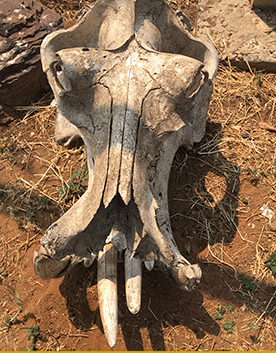 |
|
Photo: Gila
Yudkin |
|
Skeleton of a hippo seen on safari
in Zimbabwe |
|
|
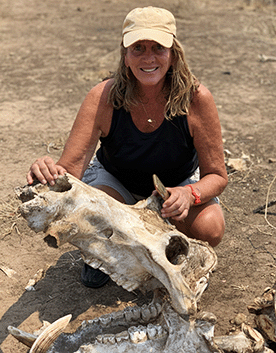 |
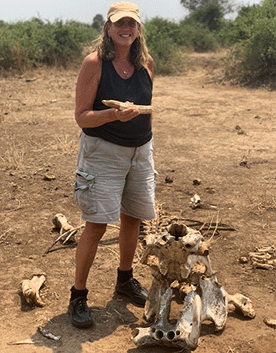 |
|
Photo: Shawn S |
Photo: Shawn S |
|
Hippopotamus skull and incisor
tooth found on 2021 safari in Zimbabwe |
|
|
|
Our guide Jefferson pointed out the skull and spinal
cord resting on the ground. He estimated that
the hippo had died about four years prior and that
it would have taken about a year to decompose.
The incisor tooth was prominent and when I touched
it, it fell out. When I held it, the tooth was
solid and felt very heavy. It definitely could
have been carved into the equivalent of our "ivory
pomegranate." |
|
|
|
When I returned to Jerusalem, I walked through the
Valley of the Cross to the Israel Museum to examine
the “ivory” pomegranate. Alas, during the pandemic,
the archeology exhibit hall had been reorganized and
the ivory pomegranate had vanished from its display
case. |
|
|
|
Sometime later, however, I discovered
the pomegranate in a showcase with a new label, “Is
this a genuine antiquity?” The commentary noted the
controversy over its authenticity, mentioning the
prevalence of forgeries. |
|
|
|
To this very day, opinion is divided on whether this
artifact was indeed present in Solomon’s Temple.
All scholars agree that the pomegranate itself is
authentic; however, some believe it was fraudulently
inscribed in modern times. But if
the inscription is indeed authentic, then the small
thumb-sized ivory colored pomegranate represents the only physical evidence of
Solomon’s Temple in Jerusalem. |
|
|
|
Postscript: How did the “ivory” pomegranate end up
in an antiquities shop? |
|
|
|
It obviously was stolen by a workman at a dig.
I imagined that it had been found on or near the
2,000 year old sidewalk under Robinson’s Arch
excavated by Meir Ben Dov’s team.
But in my exchange with Meir Ben Dov on the cable
car at Masada, that idea was put to rest. |
|
|
|
 |
|
Photo: Gila
Yudkin |
|
2,000 year old sidewalk under
Robinson's Arch where Ben Dov's team excavated |
Because the object was “found” in an antiquities
shop, we shall never know for sure. |
|
|
|
Copyright 2025 Gila Yudkin.
Permission needed to reprint in any medium. |
| |
| Since
Gila
became a guide over 40 years ago, she has been
intrigued by archeological mysteries. She
follows all the latest digs, conjectures and
archeological gossip. Her tours are a mix of
fact, fun, fantasy and spontaneity. She
relishes showing her groups how archeology has shed
light upon the biblical text. |
| |
| Do
safaris interest you? Would you like to know
whether David ever saw a leopard? Me too.
Read about my
quest to spot a leopard in the Judean wilderness. |
| |
|
 |
|
Photo: Gila
Yudkin |
|
The leopard I finally spotted was
in Africa, not in the Judean wilderness! |
| |
|
Read the story about one of my
tourists finding an ostracon at Qumran -- the first
piece of writing to be discovered at Qumran since
the site was excavated in the middle of the last
century in "Let's
inspect the ancient scroll of Isaiah." |

